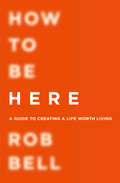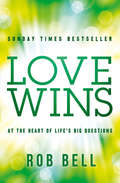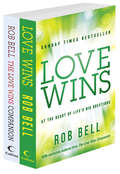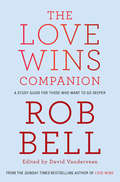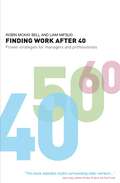- Table View
- List View
How To Be Here: How To Find Your Path And Thrive
by Rob Bell‘New York Times’ bestselling author Rob Bell shows us how to discover the greatness we were born for, successfully pursue our dreams, find our path, and live confident, fulfilled lives.
Love Wins: At The Heart Of Life's Big Questions
by Rob BellBestselling author Rob Bell offers a provocative book which gets to the heart of questions about life and death. His perspective, encapsulated by his famous slogan ‘love wins’, will surprise and challenge both Christians and atheists, and will inspire people of all faiths and none.
Love Wins and The Love Wins Companion
by Rob BellThis two-book edition combines Rob Bell’s bestselling Love Wins with the Love Wins Companion, helping you get the most out of this pioneering book.
The Love Wins Companion: A Study Guide For Those Who Want To Go Deeper
by Rob BellFor anyone who wants to delve deeper into Rob Bell’s bestselling Love Wins, the expansive and accessible Love Wins Companion offers scholarly support and critiques, resources for individuals, groups, and classes, and brand new material by Rob Bell himself.
Sex God: Exploring The Endless Questions Between Spirituality And Sexuality (G - Reference, Information And Interdisciplinary Subjects Ser.)
by Rob BellSex God, Rob Bell’s follow-up to the bestselling Velvet Elvis, tackles the controversial relationship between sexuality and spirituality. Published as part of the Rob Bell Classic relaunch, Sex God explores the links between love, sex, and God.
Velvet Elvis: Repainting The Christian Faith
by Rob BellPerhaps more relevant than ever before, Rob Bell’s Velvet Elvis is his original and bestselling classic. In Velvet Elvis, Bell invites readers to wrestle with their faith, and offers a radical new perspective on Jesus, the church, and Christianity today.
What is the Bible?: How An Ancient Library Of Poems, Letters And Stories Can Transform The Way You Think And Feel About Everything
by Rob BellThe New York Times bestselling author Rob Bell, using his inspired and inquisitive approach, focuses on the most widely read book of all time. He provides surprising insights and answers about how the Bible actually works as a source of faith and guidance, showing a brand-new way of reading this sacred text.
What We Talk About When We Talk About God: A Special Edition
by Rob BellRob Bell’s bestselling book Love Wins struck a powerful chord with a new generation of Christians who are asking the questions church leaders have been afraid to touch. His new book, What We Talk About When We Talk About God, continues down this path, helping us with the ultimate big-picture issue: how do we know God?
The ZimZum of Love: The Secret To Making Marriages Flourish (G - Reference, Information And Interdisciplinary Subjects Ser.)
by Rob Bell Kristen BellSunday Times bestselling author Rob Bell is joined in this book by his wife of twenty years, Kristen, to present a new way to make marriage work.
Jesus Wants to Save Christians: A Manifesto For The Church In Exile
by Rob Bell Don GoldenRob Bell’s highly-praised third book, Jesus Wants to Save Christians, is his most political yet. Published as part of the Rob Bell Classics relaunch, this is an inspiring call-to-arms for Christians to tackle poverty, inequality and oppression.
Conduction in Carbon Nanotube Networks: Large-Scale Theoretical Simulations (Springer Theses)
by Robert A. BellThis thesis exploits the ability of the linear-scaling quantum mechanical code ONETEP to analyze systems containing many thousands of atoms. By implementing an electron transport capability to the code, it also investigates a range of phenomena associated with electrical conduction by nanotubes and, in particular, the process of transport electrons between tubes.Extensive work has been done on the conductivity of single carbon nanotubes. However, any realistic wire made of nanotubes will consist of a large number of tubes of finite length. The conductance of the resulting wire is expected to be limited by the process of transferring electrons from one tube to another.These quantum mechanical calculations on very large systems have revealed a number of incorrect claims made previously in the literature. Conduction processes that have never before been studied at this level of theory are also investigated.
America's Disaster Culture: The Production of Natural Disasters in Literature and Pop Culture
by Robert C. Bell Robert M. FicocielloAre we inside the era of disasters or are we merely inundated by mediated accounts of events categorized as catastrophic? America's Disaster Culture offers answers to this question and a critical theory surrounding the culture of “natural” disasters in American consumerism, literature, media, film, and popular culture. In a hyper-mediated global culture, disaster events reach us with great speed and minute detail, and Americans begin forming, interpreting, and historicizing catastrophes simultaneously with fellow citizens and people worldwide. America's Disaster Culture is not policy, management, or relief oriented. It offers an analytical framework for the cultural production and representation of disasters, catastrophes, and apocalypses in American culture. It focuses on filling a need for critical analysis centered upon the omnipresence of real and imagined disasters, epidemics, and apocalypses in American culture. However, it also observes events, such as the Dust Bowl, Hurricane Katrina, and 9/11, that are re-framed and re-historicized as “natural” disasters by contemporary media and pop culture. Therefore, America's Disaster Culture theorizes the very parameters of classifying any event as a “natural” disaster, addresses the biases involved in a catastrophic event's public narrative, and analyzes American culture's consumption of a disastrous event. Looking toward the future, what are the hypothetical and actual threats to disaster culture? Or, are we oblivious that we are currently living in a post-apocalyptic landscape?
America's Disaster Culture: The Production of Natural Disasters in Literature and Pop Culture
by Robert C. Bell Robert M. FicocielloAre we inside the era of disasters or are we merely inundated by mediated accounts of events categorized as catastrophic? America's Disaster Culture offers answers to this question and a critical theory surrounding the culture of “natural” disasters in American consumerism, literature, media, film, and popular culture. In a hyper-mediated global culture, disaster events reach us with great speed and minute detail, and Americans begin forming, interpreting, and historicizing catastrophes simultaneously with fellow citizens and people worldwide. America's Disaster Culture is not policy, management, or relief oriented. It offers an analytical framework for the cultural production and representation of disasters, catastrophes, and apocalypses in American culture. It focuses on filling a need for critical analysis centered upon the omnipresence of real and imagined disasters, epidemics, and apocalypses in American culture. However, it also observes events, such as the Dust Bowl, Hurricane Katrina, and 9/11, that are re-framed and re-historicized as “natural” disasters by contemporary media and pop culture. Therefore, America's Disaster Culture theorizes the very parameters of classifying any event as a “natural” disaster, addresses the biases involved in a catastrophic event's public narrative, and analyzes American culture's consumption of a disastrous event. Looking toward the future, what are the hypothetical and actual threats to disaster culture? Or, are we oblivious that we are currently living in a post-apocalyptic landscape?
Finding Work After 40: Proven Strategies for Managers and Professionals
by Robin McKay Bell Liam MifsudAgeism is now a massive problem for older managers and professionals who have been made redundant. The guide presents a successful programme for mature workers, one that has been developed and tested by a network of executive job clubs. Readers are taken through a process of self-assessment, shown how to re-examine their career goals in light of their age, and then given a set of tools to help achieve their objectives, whether it is finding new employment or becoming self-employed.
The Tunnel Effect in Chemistry
by Ronald Percy BellThe suggestion that quantum-mechanical tunnelling might be a significant factor in some chemical reactions was first made fifty years ago by Hund, very soon after the principles of wave mechanics had been established by de Broglie, Schrodinger and Heisenberg, and similar ideas were put forward during the following thirty years by a number of authors. It was realised from the beginning that such effects would be particularly prominent in reactions involving the movement of protons or hydrogen atoms, and both theoretical and experimental work received a powerful stimulus in the discovery of deuterium in 1932. During the last twenty years theoretical predictions about the tunnel effect have been supported by an increasing body of experimental evidence, derived especially from studies of hydrogen isotope effects. The present book presents an attempt to summarize this evidence and to indicate the main lines of the basic theory. Details of mathematical manipu lation are restricted mainly to Chapter 2 and the Appendices, and many readers may prefer to confine themselves to the results obtained. The main emphasis has been on the kinetics of chemical reactions involving the transfer of protons, hydrogen atoms or hydride ions, although Chapter 6 gives an account of the role of the tunnel effect in molecular spectra, and Chapter 7 makes some mention of tunnelling in solid state phenomena, biological processes and the electrolytic discharge of hydrogen. Only passing references have been made to tunnelling by electrons.
The Proton in Chemistry
by R.P. BellThe first edition of this book was based on the lectures which I gave at Cornell University during 1958 as George Fisher Baker Lecturer, and I would like to repeat my warmest thanks to Professor F. A. Long and the other members of the Department of Chemistry for their kindness and helpful advice. The present edition was largely written during the tenure of a Visiting Professorship awarded by the Royal Society and the Israeli Academy of Sciences. I am deeply indebted to both of these bodies and also to the hospitality of the Weizmann Institute of Science, in particular to Professor David Samuel and Professor F. S. Klein of the Isotopes Research Department. The subject as a whole has expanded greatly since 1959, especially in two fields, namely, the direct study of fast proton-transfer reactions (notably by the relaxation methods pioneered by Eigen), and the experi mental and theoretical study of hydrogen isotope effects. In order to keep the size of the book within reasonable bounds it has been necessary to adopt a selective policy, and this is particularly the case in Chapter 9 where I have chosen to treat a few types of reaction in some detail rather than to attempt a more complete coverage.
Fate, Honor, Family and Village: Demographic and Cultural Change in Rural Italy Since 1800
by Rudolph M. BellThe Italian peasantry has often been described as tragic, backward, hopeless, downtrodden, static, and passive. In Fate and Honor, Family and Village, Rudolph Bell argues against this characterization by reconstructing the complete demographic history of four country villages since 1800. He analyzes births, marriages, and deaths in terms of four concepts that capture more accurately and sympathetically the essence of the Italian peasant's life: Fortuna (fate), onore (honor, dignity), famiglia (family), and campanilismo (village).Fortuna is the cultural wellspring of Italian peasant society, the worldview from which all social life flows. The concept of Fortuna does not refer to philosophical questions, predestination, or value judgments. Rather, Fortuna is the sum total of all explanations of outcomes perceived to be beyond human control. Thus, in Bell's view, high mortality does not lead peasants to a resigned acceptance of their fate; instead, they rely on honor, reciprocal exchanges of favors, and marriage to forge new links in their familial and social networks. With thorough documentation in graphs and tables, the author evaluates peasant reactions to time, work, family, space, migration, and protest to portray rural Italians as active, flexible, and shrewd, participating fully in shaping their destinies.Bell asserts that the real problem of the Mezzogiorno is not one of resistance to technology, of high birth rates, or even of illiteracy. It is one of solving technical questions in ways that foster dependency. The historical and sociological practice of treating peasant culture as backward, secondary, and circumscribed only encourages disruption and ultimately blocks the road to economic and political justice in a post-modern world.
Fate, Honor, Family and Village: Demographic and Cultural Change in Rural Italy Since 1800
by Rudolph M. BellThe Italian peasantry has often been described as tragic, backward, hopeless, downtrodden, static, and passive. In Fate and Honor, Family and Village, Rudolph Bell argues against this characterization by reconstructing the complete demographic history of four country villages since 1800. He analyzes births, marriages, and deaths in terms of four concepts that capture more accurately and sympathetically the essence of the Italian peasant's life: Fortuna (fate), onore (honor, dignity), famiglia (family), and campanilismo (village).Fortuna is the cultural wellspring of Italian peasant society, the worldview from which all social life flows. The concept of Fortuna does not refer to philosophical questions, predestination, or value judgments. Rather, Fortuna is the sum total of all explanations of outcomes perceived to be beyond human control. Thus, in Bell's view, high mortality does not lead peasants to a resigned acceptance of their fate; instead, they rely on honor, reciprocal exchanges of favors, and marriage to forge new links in their familial and social networks. With thorough documentation in graphs and tables, the author evaluates peasant reactions to time, work, family, space, migration, and protest to portray rural Italians as active, flexible, and shrewd, participating fully in shaping their destinies.Bell asserts that the real problem of the Mezzogiorno is not one of resistance to technology, of high birth rates, or even of illiteracy. It is one of solving technical questions in ways that foster dependency. The historical and sociological practice of treating peasant culture as backward, secondary, and circumscribed only encourages disruption and ultimately blocks the road to economic and political justice in a post-modern world.
Holy Anorexia
by Rudolph M. BellIs there a resemblance between the contemporary anorexic teenager counting every calorie in her single-minded pursuit of thinness, and an ascetic medieval saint examining her every desire? Rudolph M. Bell suggests that the answer is yes. "Everyone interested in anorexia nervosa . . . should skim this book or study it. It will make you realize how dependent upon culture the definition of disease is. I will never look at an anorexic patient in the same way again."—Howard Spiro, M.D., Gastroenterology "[This] book is a first-class social history and is well-documented both in its historical and scientific portions."—Vern L. Bullough, American Historical Review "A significant contribution to revisionist history, which re-examines events in light of feminist thought. . . . Bell is particularly skillful in describing behavior within its time and culture, which would be bizarre by today's norms, without reducing it to the pathological."—Mary Lassance Parthun, Toronto Globe and Mail "Bell is both enlightened and convincing. His book is impressively researched, easy to read, and utterly fascinating."—Sheila MacLeod, New Statesman
Holy Anorexia
by Rudolph M. BellIs there a resemblance between the contemporary anorexic teenager counting every calorie in her single-minded pursuit of thinness, and an ascetic medieval saint examining her every desire? Rudolph M. Bell suggests that the answer is yes. "Everyone interested in anorexia nervosa . . . should skim this book or study it. It will make you realize how dependent upon culture the definition of disease is. I will never look at an anorexic patient in the same way again."—Howard Spiro, M.D., Gastroenterology "[This] book is a first-class social history and is well-documented both in its historical and scientific portions."—Vern L. Bullough, American Historical Review "A significant contribution to revisionist history, which re-examines events in light of feminist thought. . . . Bell is particularly skillful in describing behavior within its time and culture, which would be bizarre by today's norms, without reducing it to the pathological."—Mary Lassance Parthun, Toronto Globe and Mail "Bell is both enlightened and convincing. His book is impressively researched, easy to read, and utterly fascinating."—Sheila MacLeod, New Statesman
Holy Anorexia
by Rudolph M. BellIs there a resemblance between the contemporary anorexic teenager counting every calorie in her single-minded pursuit of thinness, and an ascetic medieval saint examining her every desire? Rudolph M. Bell suggests that the answer is yes. "Everyone interested in anorexia nervosa . . . should skim this book or study it. It will make you realize how dependent upon culture the definition of disease is. I will never look at an anorexic patient in the same way again."—Howard Spiro, M.D., Gastroenterology "[This] book is a first-class social history and is well-documented both in its historical and scientific portions."—Vern L. Bullough, American Historical Review "A significant contribution to revisionist history, which re-examines events in light of feminist thought. . . . Bell is particularly skillful in describing behavior within its time and culture, which would be bizarre by today's norms, without reducing it to the pathological."—Mary Lassance Parthun, Toronto Globe and Mail "Bell is both enlightened and convincing. His book is impressively researched, easy to read, and utterly fascinating."—Sheila MacLeod, New Statesman
Holy Anorexia
by Rudolph M. BellIs there a resemblance between the contemporary anorexic teenager counting every calorie in her single-minded pursuit of thinness, and an ascetic medieval saint examining her every desire? Rudolph M. Bell suggests that the answer is yes. "Everyone interested in anorexia nervosa . . . should skim this book or study it. It will make you realize how dependent upon culture the definition of disease is. I will never look at an anorexic patient in the same way again."—Howard Spiro, M.D., Gastroenterology "[This] book is a first-class social history and is well-documented both in its historical and scientific portions."—Vern L. Bullough, American Historical Review "A significant contribution to revisionist history, which re-examines events in light of feminist thought. . . . Bell is particularly skillful in describing behavior within its time and culture, which would be bizarre by today's norms, without reducing it to the pathological."—Mary Lassance Parthun, Toronto Globe and Mail "Bell is both enlightened and convincing. His book is impressively researched, easy to read, and utterly fascinating."—Sheila MacLeod, New Statesman
How to Do It: Guides to Good Living for Renaissance Italians
by Rudolph M. BellHow to Do It shows us sixteenth-century Italy from an entirely new perspective: through manuals which were staples in the households of middlebrow Italians merely trying to lead better lives. Addressing challenges such as how to conceive a boy, the manuals offered suggestions such as tying a tourniquet around your husband's left testicle. Or should you want to goad female desires, throw 90 grubs in a liter of olive oil, let steep in the sun for a week and apply liberally on the male anatomy. Bell's journey through booklets long dismissed by scholars as being of little literary value gives us a refreshing and surprisingly fun social history. "Lively and curious reading, particularly in its cascade of anecdote, offered in a breezy, cozy, journalistic style." —Lauro Martines, Times Literary Supplement "[Bell's] fascinating book is a window on a lost world far nearer to our own than we might imagine. . . . How pleasant to read his delightful, informative and often hilarious book." —Kate Saunders, The Independent "An extraordinary work which blends the learned with the frankly bizarre." —The Economist "Professor Bell has a sly sense of humor and an enviably strong stomach. . . . He wants to know how people actually behaved, not how the Church or philosophers or earnest humanists thought they should behave. I loved this book." —Christopher Stace, Daily Telegraph
How to Do It: Guides to Good Living for Renaissance Italians
by Rudolph M. BellHow to Do It shows us sixteenth-century Italy from an entirely new perspective: through manuals which were staples in the households of middlebrow Italians merely trying to lead better lives. Addressing challenges such as how to conceive a boy, the manuals offered suggestions such as tying a tourniquet around your husband's left testicle. Or should you want to goad female desires, throw 90 grubs in a liter of olive oil, let steep in the sun for a week and apply liberally on the male anatomy. Bell's journey through booklets long dismissed by scholars as being of little literary value gives us a refreshing and surprisingly fun social history. "Lively and curious reading, particularly in its cascade of anecdote, offered in a breezy, cozy, journalistic style." —Lauro Martines, Times Literary Supplement "[Bell's] fascinating book is a window on a lost world far nearer to our own than we might imagine. . . . How pleasant to read his delightful, informative and often hilarious book." —Kate Saunders, The Independent "An extraordinary work which blends the learned with the frankly bizarre." —The Economist "Professor Bell has a sly sense of humor and an enviably strong stomach. . . . He wants to know how people actually behaved, not how the Church or philosophers or earnest humanists thought they should behave. I loved this book." —Christopher Stace, Daily Telegraph
How to Do It: Guides to Good Living for Renaissance Italians
by Rudolph M. BellHow to Do It shows us sixteenth-century Italy from an entirely new perspective: through manuals which were staples in the households of middlebrow Italians merely trying to lead better lives. Addressing challenges such as how to conceive a boy, the manuals offered suggestions such as tying a tourniquet around your husband's left testicle. Or should you want to goad female desires, throw 90 grubs in a liter of olive oil, let steep in the sun for a week and apply liberally on the male anatomy. Bell's journey through booklets long dismissed by scholars as being of little literary value gives us a refreshing and surprisingly fun social history. "Lively and curious reading, particularly in its cascade of anecdote, offered in a breezy, cozy, journalistic style." —Lauro Martines, Times Literary Supplement "[Bell's] fascinating book is a window on a lost world far nearer to our own than we might imagine. . . . How pleasant to read his delightful, informative and often hilarious book." —Kate Saunders, The Independent "An extraordinary work which blends the learned with the frankly bizarre." —The Economist "Professor Bell has a sly sense of humor and an enviably strong stomach. . . . He wants to know how people actually behaved, not how the Church or philosophers or earnest humanists thought they should behave. I loved this book." —Christopher Stace, Daily Telegraph
